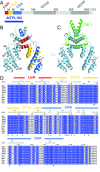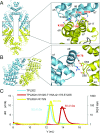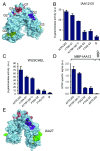Structure of the Arabidopsis TOPLESS corepressor provides insight into the evolution of transcriptional repression
- PMID: 28698367
- PMCID: PMC5544296
- DOI: 10.1073/pnas.1703054114
Structure of the Arabidopsis TOPLESS corepressor provides insight into the evolution of transcriptional repression
Abstract
Transcriptional repression involves a class of proteins called corepressors that link transcription factors to chromatin remodeling complexes. In plants such as Arabidopsis thaliana, the most prominent corepressor is TOPLESS (TPL), which plays a key role in hormone signaling and development. Here we present the crystallographic structure of the Arabidopsis TPL N-terminal region comprising the LisH and CTLH (C-terminal to LisH) domains and a newly identified third region, which corresponds to a CRA domain. Comparing the structure of TPL with the mammalian TBL1, which shares a similar domain structure and performs a parallel corepressor function, revealed that the plant TPLs have evolved a new tetramerization interface and unique and highly conserved surface for interaction with repressors. Using site-directed mutagenesis, we validated those surfaces in vitro and in vivo and showed that TPL tetramerization and repressor binding are interdependent. Our results illustrate how evolution used a common set of protein domains to create a diversity of corepressors, achieving similar properties with different molecular solutions.
Keywords: TOPLESS; auxin signaling; corepressor; crystal structure; tetramerization.
Conflict of interest statement
The authors declare no conflict of interest.
Figures






Similar articles
-
Repression by the Arabidopsis TOPLESS corepressor requires association with the core mediator complex.Elife. 2021 Jun 2;10:e66739. doi: 10.7554/eLife.66739. Elife. 2021. PMID: 34075876 Free PMC article.
-
Repressor for hire! The vital roles of TOPLESS-mediated transcriptional repression in plants.New Phytol. 2021 Aug;231(3):963-973. doi: 10.1111/nph.17428. Epub 2021 May 30. New Phytol. 2021. PMID: 33909309 Review.
-
TOPLESS co-repressor interactions and their evolutionary conservation in plants.Plant Signal Behav. 2012 Mar;7(3):325-8. doi: 10.4161/psb.19283. Epub 2012 Mar 1. Plant Signal Behav. 2012. PMID: 22476455 Free PMC article.
-
CC-type glutaredoxins recruit the transcriptional co-repressor TOPLESS to TGA-dependent target promoters in Arabidopsis thaliana.Biochim Biophys Acta Gene Regul Mech. 2017 Feb;1860(2):218-226. doi: 10.1016/j.bbagrm.2016.11.001. Epub 2016 Nov 9. Biochim Biophys Acta Gene Regul Mech. 2017. PMID: 27838237
-
TOPLESS in the regulation of plant immunity.Plant Mol Biol. 2022 May;109(1-2):1-12. doi: 10.1007/s11103-022-01258-9. Epub 2022 Mar 28. Plant Mol Biol. 2022. PMID: 35347548 Review.
Cited by
-
Canonical and Alternative Auxin Signaling Systems in Mono-, Di-, and Tetraploid Potatoes.Int J Mol Sci. 2023 Jul 13;24(14):11408. doi: 10.3390/ijms241411408. Int J Mol Sci. 2023. PMID: 37511169 Free PMC article.
-
Identification and mapping of expressed genes associated with the 2DL QTL for fusarium head blight resistance in the wheat line Wuhan 1.BMC Genet. 2019 May 21;20(1):47. doi: 10.1186/s12863-019-0748-6. BMC Genet. 2019. PMID: 31113363 Free PMC article.
-
An Anecdote on Prospective Protein Targets for Developing Novel Plant Growth Regulators.Mol Biotechnol. 2022 Feb;64(2):109-129. doi: 10.1007/s12033-021-00404-w. Epub 2021 Sep 25. Mol Biotechnol. 2022. PMID: 34561838 Review.
-
SnRK1α1 Antagonizes Cell Death Induced by Transient Overexpression of Arabidopsis thaliana ABI5 Binding Protein 2 (AFP2).Front Plant Sci. 2020 Sep 29;11:582208. doi: 10.3389/fpls.2020.582208. eCollection 2020. Front Plant Sci. 2020. PMID: 33133119 Free PMC article.
-
TIME FOR COFFEE regulates phytochrome A-mediated hypocotyl growth through dawn-phased signaling.Plant Cell. 2022 Jul 30;34(8):2907-2924. doi: 10.1093/plcell/koac138. Plant Cell. 2022. PMID: 35543486 Free PMC article.
References
-
- Perissi V, Jepsen K, Glass CK, Rosenfeld MG. Deconstructing repression: Evolving models of co-repressor action. Nat Rev Genet. 2010;11:109–123. - PubMed
Publication types
MeSH terms
Substances
LinkOut - more resources
Full Text Sources
Other Literature Sources
Molecular Biology Databases

